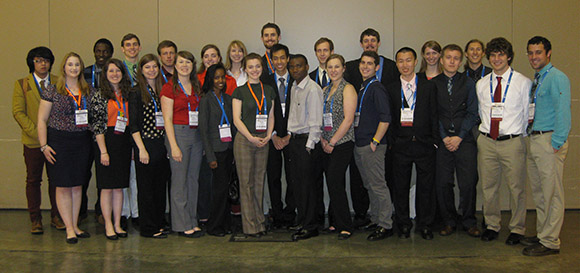
CONWAY, Ark. (April 10, 2013) - Twenty five Hendrix students presented their undergraduate
research this spring at the 45th annual American Chemical Society (ACS) national
meeting in New Orleans, La.
Approximately 12,000 professional chemists and students attended the meeting,
where Hendrix had one of the largest cohorts of undergraduate attendees.
“Undergraduate students learn most of their chemistry knowledge in the classroom.
Attending a professional conference allows students to learn about current directions
in scientific research and see highlights of novel, transformative projects that
are occurring on a national scale,” said Hendrix chemistry professor Dr. Courtney
Hatch. “Additionally, the students get to see current research driving the industry
across the country. As a myriad of chemical specialties are represented at the ACS
conference, students may find a particular research area or topic that identifies
with them, thus possibly discovering or honing in on areas of chemistry that best
fit their personal interests.”
“For undergraduates, presenting their scientific research is a very enriching
experience. Upon interacting with other chemists, the students gain insights into
their projects and results as well as identify new directions in which they may
take their projects. Additionally, they have the opportunity to obtain valuable
new contacts that can increase opportunities for careers in the field,” added Hatch.
“Students can also compare the quality of their research with that of students from
small colleges and large universities from all over the United States. When they
see that their research is just as good, or better than, that of their peers nationally,
it validates the quality of their educational experience at Hendrix.”
The students, their research poster titles, and faculty mentors include:
- Stephen Borutta of St. Louis, Mo., "Metastable Fragmentation of Photoionized
Boron Tribromide Clusters" (Dr. David Hales)
- Beth Childress of Greenwood, Ark., "Nitrate and phosphate analysis by ion
chromatography" (Dr. Liz Gron)
- Stephanie Davenport of Mountain Home, Tenn., "Urinary Chemical Signals in
Immature Male African Elephants" (Dr. Tom Goodwin)
- Brandi Gist of Paragould, Ark., and Katie Midkiff of North Little Rock,
Ark., "Visible Light Photooxidation of Tertiary Amines and Anilines" (Dr. Chris
Marvin)
- Jessica Hook of Hot Springs, Ark., "Metal Ion Cofactor Requirements for
Phospholipase A2" (Dr. Randy Kopper)
- McKenzie Keller of Rogers, Ark., "Impacts of Aeolian Dust on Phytoplankton
Growth Rates" (Dr. Courtney Hatch)
- Jake Leffert of Conway, Ark., "Approaches to the Synthesis of Glucuronide
Derivatives of Enantiomerically-Enriched Warfarin (Coumadin)" (Dr. Tom Goodwin)
- Cheryl Mathis of Chesterfield, Mo., and Adam Grippo of Jonesboro, Ark.,
"Visible Light Photooxidation of N-alkyl Tetrahydropyridines" (Dr. Chris Marvin)
- Michael Nollen of Conway, Ark., "Photofragmentation of Photoionized Boron
Tribromide Clusters" (Dr. David Hales)
- Robert Nshimiyimana "Adventures in green organic chemistry (with aspirin
and other esters)" (Dr. Tom Goodwin)
- Etienne Nzabarushimana of Rwanda "Oxidative Stress from Docosahexaenoic
Acid Increases Antioxidant Protection in HepG2 Cells" (Dr. Andres Caro)
- Logan Rice of Hot Springs, Ark., "CYP2E1 overexpression induces mitochondrial
biogenesis in HepG2 cells" (Dr. Andres Caro)
- Spencer Sanson of Baton Rouge, La., "The effects of ethanol on hepg2 cells"
(Dr. Andres Caro)
- Michael Tarne of Shawnee, Kan., "New dirhenium paddlewheel compounds with
alternating O,O'- and N, N'- bridging ligands" (Dr. Michael Dequeant)
- Paul Taucher of Texarkana, Ark.,"Computational Study of Photoionized Boron
Trichloride Clusters" (Dr. David Hales)
- Johnny Tran of Fort Smith, Ark.,"Docosahexaenoic Acid Induces Mitochondrial Biogenesis in HepG2
Cells" (Dr. Andres Caro)
- Aline Umuhire-Juru of Rwanda "Bacterial Metabolism Produces Exogenous Urinary
Chemical Signals of Elephant Musth" (Dr. Tom Goodwin)
- Olivia Urbanowicz of Arvada, Colo., "Adsorption of snake venom proteins by activated charcoal" (Dr. Randy Kopper)
- Rob Weingold of Jonesboro, Ark.,"A study of the heterogeneous chemistry
of formic acid on mineral dusts by dual chamber transmission FT-IR flow reaction
system" and (Dr. Courtney Hatch)
- Alexandra Wilson of Spanish Fort, Ala.,"Volatile organic chemicals in secretions
and excretions of Alaska river otters' (Dr. Tom Goodwin)
- Lin Xu of Chengdu Sichuan, China, "Green organic chemistry experiments:
glyoxylamide synthesis via ring opening of N-acetylisatins with amino
acid methyl esters" (Dr. Tom Goodwin)
- Qin Yin of WuXi City Jiangsu, China, "Identification and quantitation of
fatty acids in male elephant urine that may be metabolized to produce chemical
signals of must" (Dr. Tom Goodwin)
- Sloane Zimmerman of Mountain Home, Ark., "Comparison of Coral Snake Venom
Components between Individuals" (Dr. Randy Kopper)
Hendrix students were accompanied by seven faculty and staff members of the Department
of Chemistry.
Founded in 1876, Hendrix College is a national leader in engaged liberal arts
and sciences education. For the fifth consecutive year, Hendrix was named one of
the country's "Up and Coming" liberal arts colleges by U.S. News and World Report.
Hendrix is featured in the 2012 edition of the Princeton Review as one of the country's
best 377 colleges, the latest edition of Colleges That Change Lives: 40 Schools
That Will Change the Way You Think about Colleges, Forbes magazine's
annual list of America's Top 650 Colleges, and the 2013 edition of the Fiske Guide
to Colleges. Hendrix has been affiliated with the United Methodist Church since
1884. For more information, visit www.hendrix.edu.